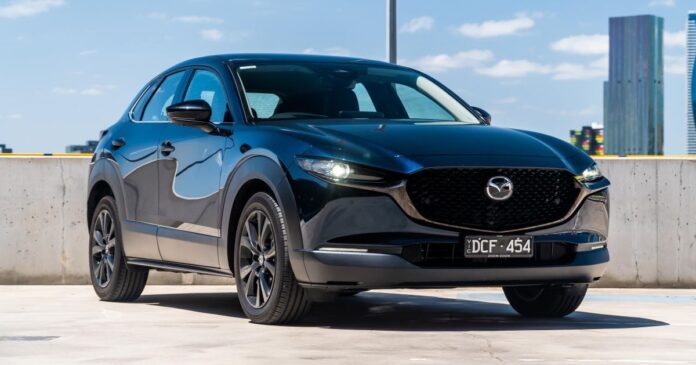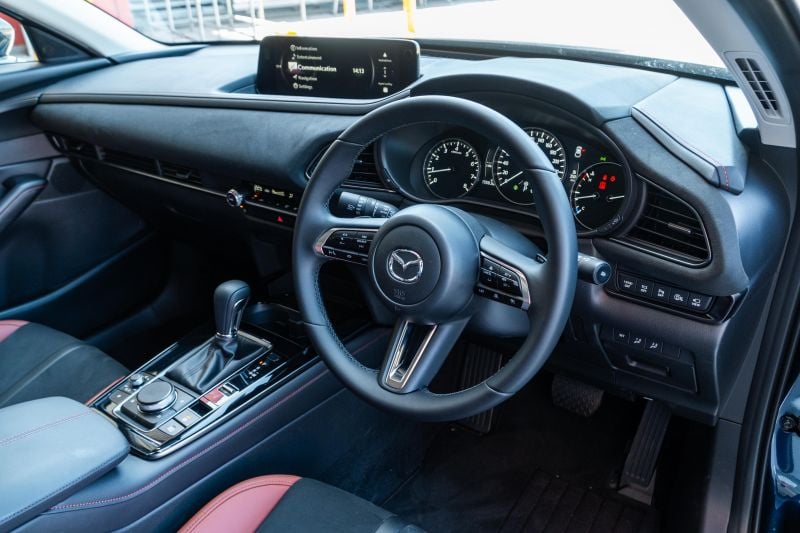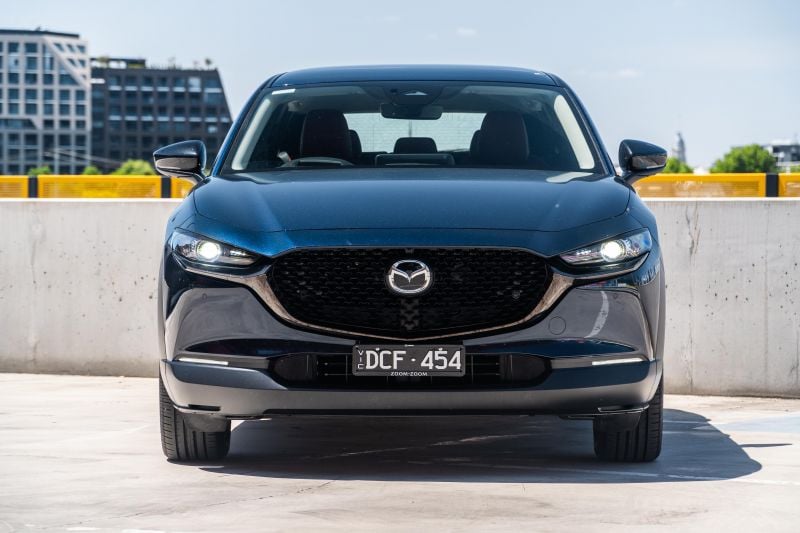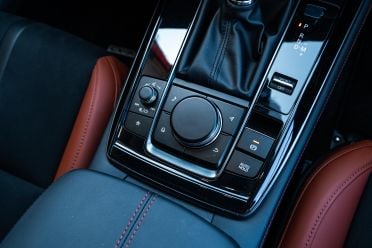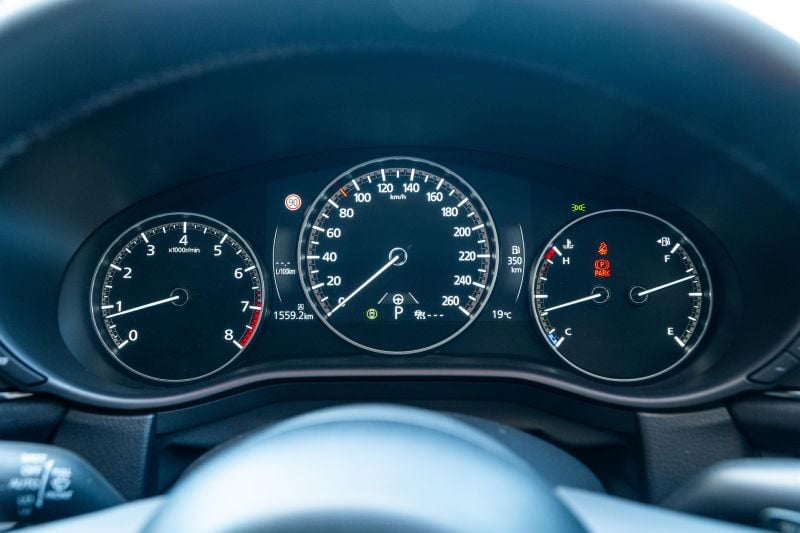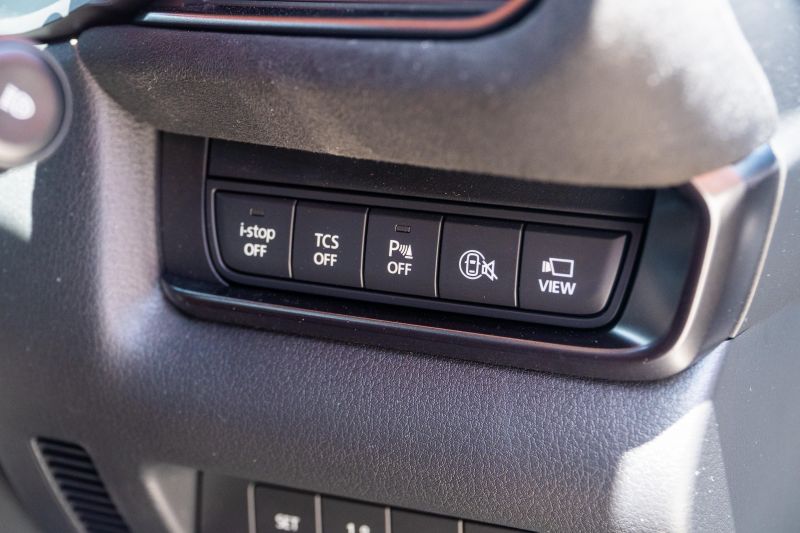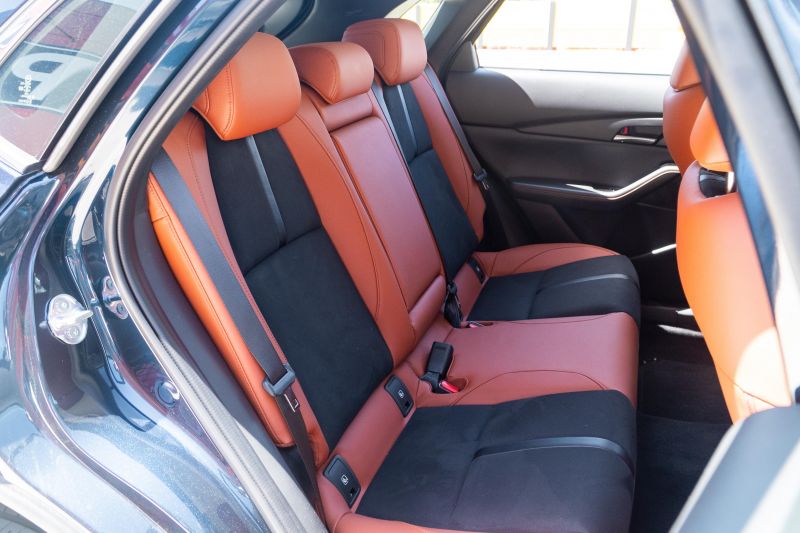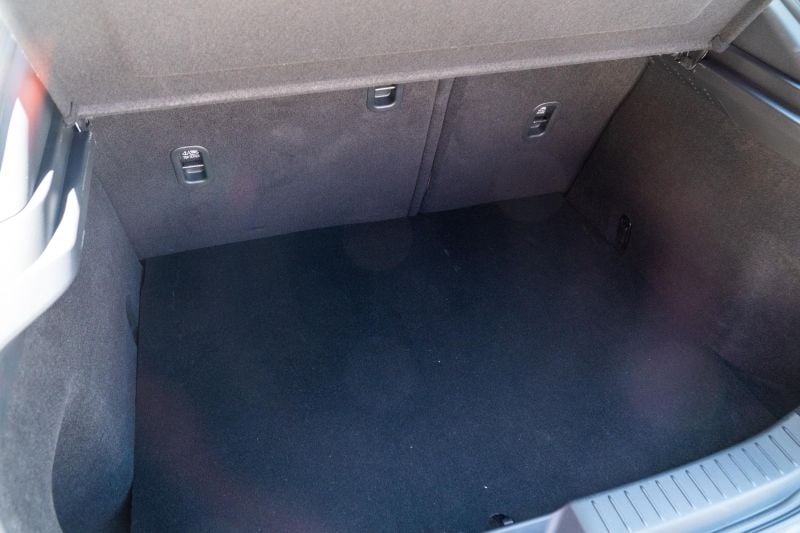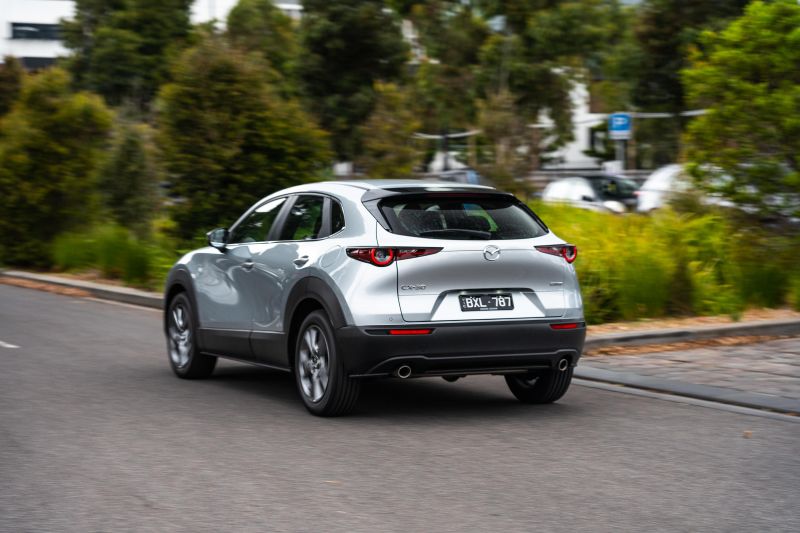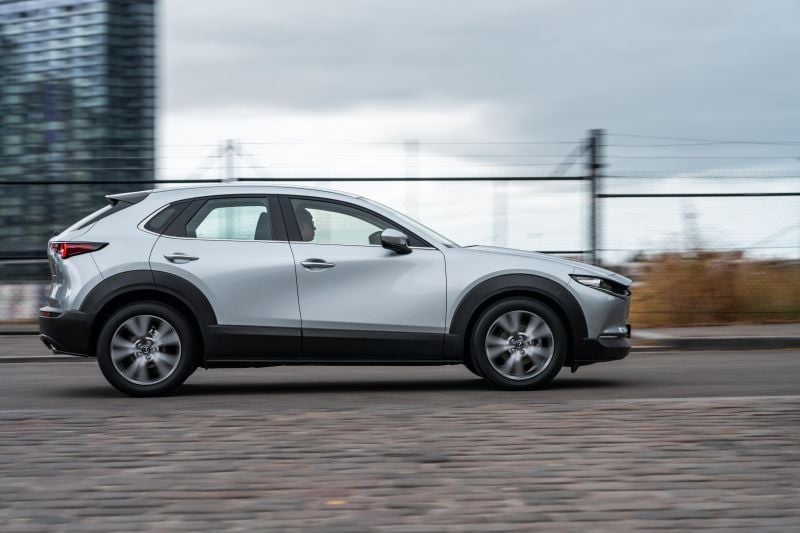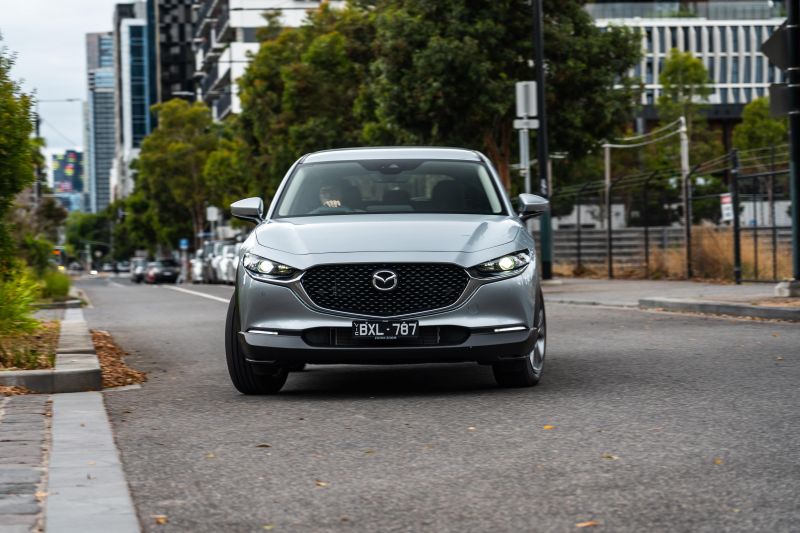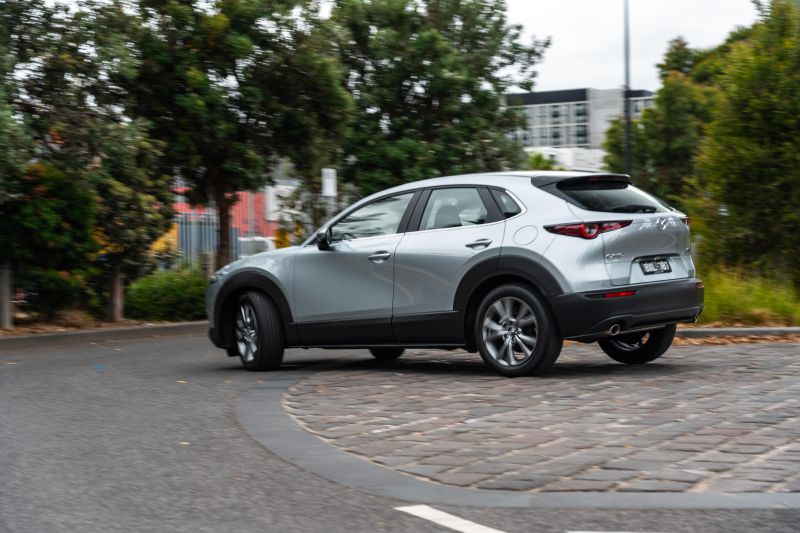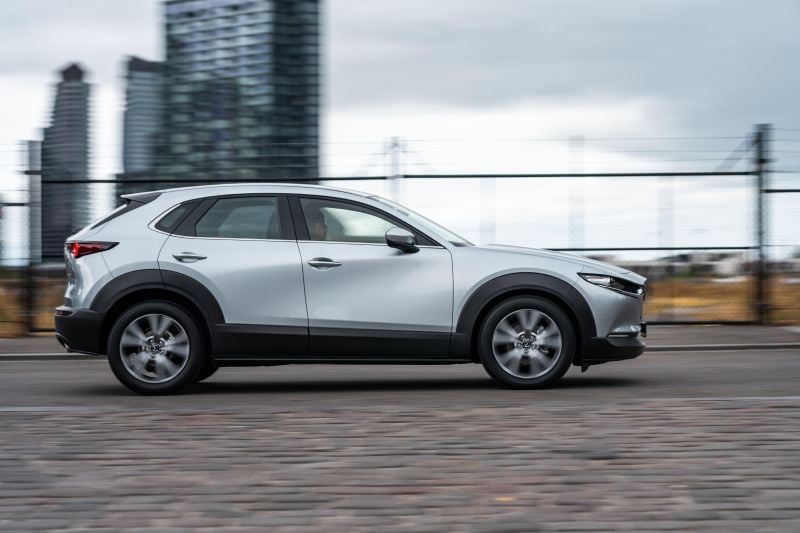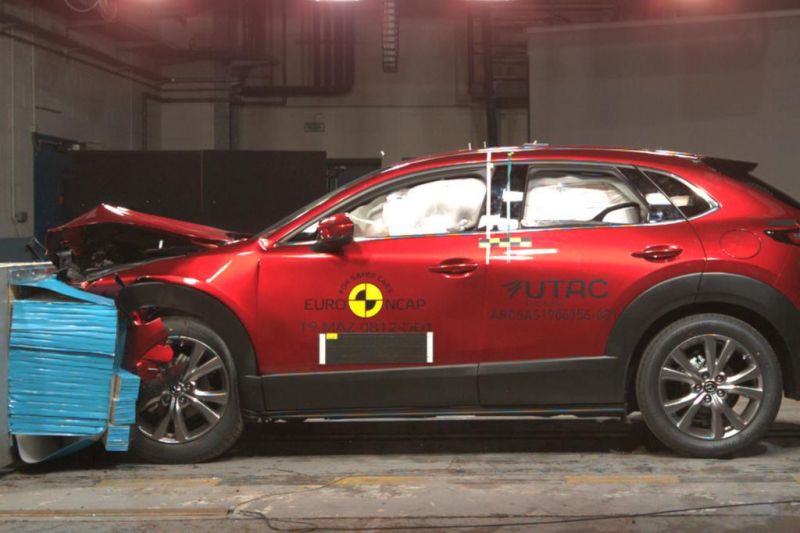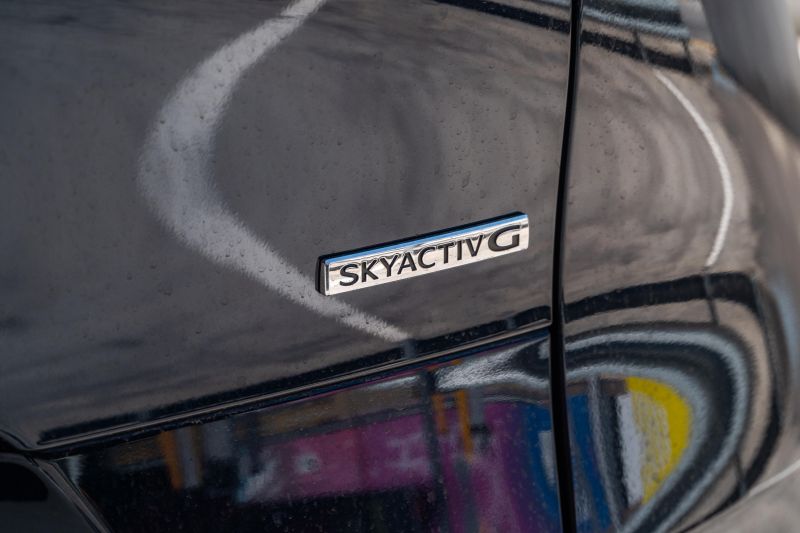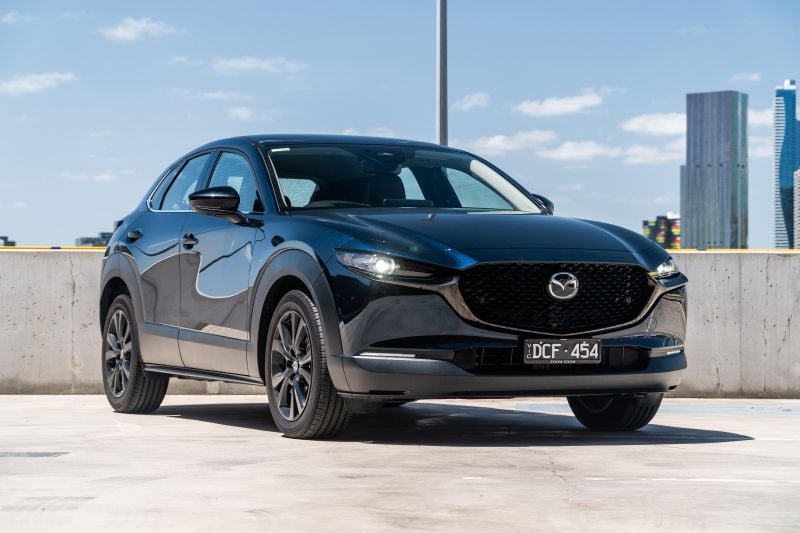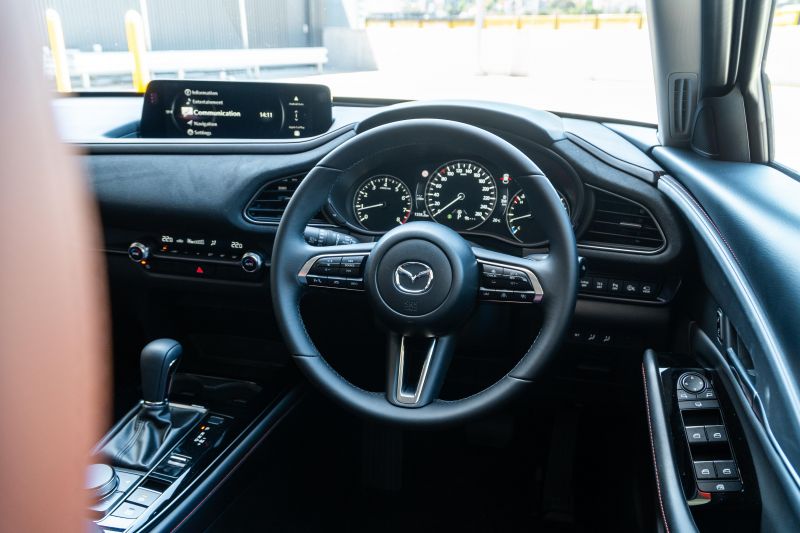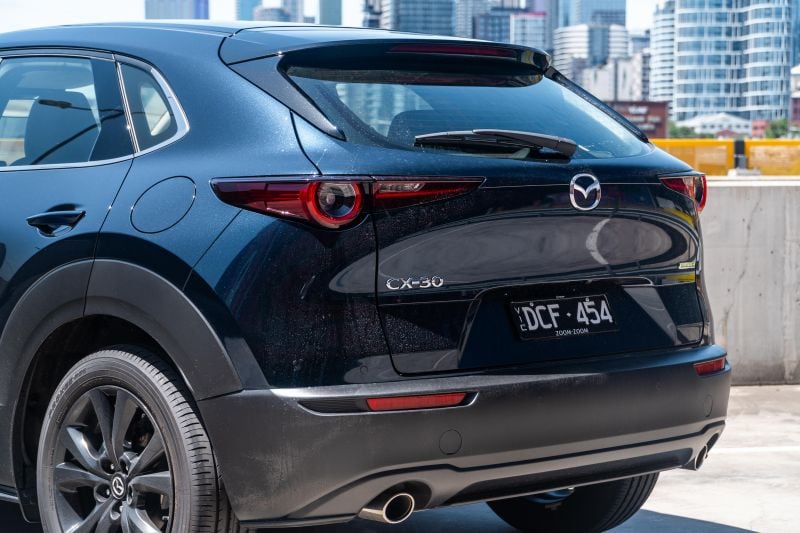In the small SUV world, Mazda continues to be a key player.
The CX-30 is its primary candidate against the likes of the Toyota Corolla Cross and Subaru Crosstrek, alongside which it continues to post respectable sales figures – even if all are lagging behind the MG ZS.
To the end of October this year, 10,803 CX-30s have been delivered in Australia, compared to the Crosstrek’s 9772 and the Corolla Cross’ 7459. So although it’s much less popular than the top-selling ZS (18,668), the CX-30 remains one of the most convincing propositions in Mazda’s lineup, and the small SUV class.
It’s ideal for young families who need to make the jump to a compact SUV, and at the same time it’s a wise choice for a first car. Its sales figures within the Mazda lineup reflect that too, as it currently sits third behind the larger CX-5 and smaller CX-3 SUVs.
While the cheaper variants may present the best value in the CX-30 range, there’s plenty to be enjoyed by moving further up the ranks and towards the $40,000 mark.
One such candidate is the vehicle on test here: the 2025 Mazda CX-30 G20 Touring LE.
It’s the second-most expensive CX-30 fitted with a 2.0-litre engine, while still being more expensive than the most comparable 2.5-litre option.
Inside, you get tasty goodies like uniquely coloured upholstery, and you benefit from Mazda hallmarks like a quality infotainment system and spot-on ergonomics.
Is it worth spending a little bit more for a higher-end 2.0-litre CX-30, or should you jump to the larger-displacement alternative instead?
How does the Mazda CX-30 compare?
View a detailed breakdown of the Mazda CX-30 against similarly sized vehicles.

Mazda
CX-30
The Touring LE sits right in the middle of Mazda’s CX-30 lineup. It carries a $2300 premium over the standard 2.0-litre Touring, and costs $800 more than the 2.5-litre Touring.
| Model | Price before on-road costs |
|---|---|
| 2025 Mazda CX-30 G20 Pure | $33,940 |
| 2025 Mazda CX-30 G20 Evolve | $35,840 |
| 2025 Mazda CX-30 G20 Touring | $39,640 |
| 2025 Mazda CX-30 G25 Touring | $41,140 |
| 2025 Mazda CX-30 G20 Touring LE | $41,940 |
| 2025 Mazda CX-30 G20 Astina | $44,840 |
| 2025 Mazda CX-30 G25 GT SP | $43,140 |
| 2025 Mazda CX-30 G25 GT SP AWD | $45,140 |
| 2025 Mazda CX-30 G25 Astina | $46,340 |
| 2025 Mazda CX-30 G25 Astina AWD | $48,340 |
To see how the Mazda CX-30 stacks up against its rivals, use our comparison tool
Very typically Mazda. That’s a good thing though, because it means it’s very easy to hop in and quickly get comfortably situated if you’re a first-time CX-30 driver.
A unique feature of the Touring LE is its black suede and ‘terracotta’ upholstery – or brown to you and me. It’s something a bit different for a car like this, and it does wonders to differentiate this model from the rest of the range.
The materials are high-quality too, while the seats are comfortable to sit in during long drives. That comfort is bolstered by the CX-30’s practical ergonomics – something Mazda has successfully dialled in over the past few years.
The seating position is particularly satisfying, because the high window creates a closed-in feeling that makes you feel somewhat cocooned in the car. That’s again typical of Mazda, as a similar feeling can be found in the closely related Mazda 3.
Adjustment is easy too, because the Touring LE benefits from a 10-way powered driver’s seat. It might take a moment to get everything where you like it, but all manner of drivers will be easily accounted for.
In terms of tech, some may not be pleased to find the CX-30 once again has a dial on the centre console that is used to control the infotainment system up top.
But I’m a fan of this setup; there’s something satisfying about being able to lean back and scroll through the various menus without having to lean forward and out of your seat.
It’s particularly handy in a car like the CX-30, because the positioning of the 8.8-inch infotainment system is somewhat awkward. As is now customary, it’s located in a perch atop the dashboard, but it seems to be sunken deeper into the dash than it is in models like the Mazda 3.
That means if your seating position is low, part of the screen’s bottom-right corner will be cut off by the steering wheel. Similarly, it’s quite a reach to manipulate controls situated on the far left of the screen.
At least this screen can be operated by touch while on the move, something that isn’t always the case in Mazda cars. Again that isn’t necessary, as another benefit of the central dials is that things like volume can be easily controlled by passengers in the front.
There aren’t any other physical buttons to control the infotainment system beyond those on the steering wheel either, so unless you have arms long enough to make the touchscreen comfortable the central dial is your only real option.
That’s fine if you’re primarily using Mazda’s native software interface, but it becomes rather clunky when using (wireless) Apple CarPlay or Android Auto. The four shortcuts around the large dial all work reliably when using smartphone mirroring, which is handy for switching between apps like maps and music.
In any case, the front of the CX-30 is a practical, easy place to spend time, helped by the fact there are minimal bells and whistles to clutter things up.
Nowhere is that more apparent than the instrument cluster, which features a circular dial screen flanked by two analogue gauges. The central screen can be adjusted to show a handful of different displays, though we feel the standard digital speedo is the cleanest while still showing an appropriate amount of information.
The climate control system below the infotainment display is another standard Mazda unit, but because the Touring LE isn’t a top-spec variant, there are a fair few button blanks where controls for functions like seat heating would normally be placed.
It’s still a quality unit though, and the selection of buttons you do get are easy to figure out and operate. It may take a moment to fully get to grips with the system, but all inputs provide feedback using either the small display above, or lights to show you what you’ve adjusted.
The other buttons in the cabin can be found on the steering wheel – for infotainment and driver assist controls – and to the right of the steering wheel, where you can view the various cameras or toggle the idle stop/start system.
Again it’s all clearly legible, which is exactly what you’d want from a car like this. The only real gripe is the use of gloss black plastic, as well as the dust-attracting black suede on the dashboard.
Another strength is storage up front. There’s a sizeable box under the central armrest, and ahead of the mechanical gear selector are two nicely placed cupholders – with just enough room above to fit a tall drink bottle.
There’s a passenger-side glovebox and bottle holders in each door, the latter of which isn’t quite large enough for that aforementioned drink bottle. On the ceiling is a sunglasses holder, which helps to keep items neatly out of sight and out of mind.
Ahead of the two cupholders is a wireless phone charging pad, which again is appropriately sized to fit most phones or loose items.
The second row is a relatively sparse affair. There are no amenities beyond the rear-facing air vents on the back of the centre console, which means rear seat passengers will need to ask kindly to use the USB-C ports inside that centre console.
The brown and black upholstery continues back here, but the illusion of luxury is somewhat disturbed by the grey headliner above. It’s not a dealbreaker, but a black alternative (like what you’d find in a Mazda 3) would have added that little something extra.
In the middle is a fold-down armrest with two cupholders, and there are again small-ish bottle holders in both doors. Additionally, there is a map pocket to make use of – but only on the passenger side.
It’s by no means uncomfortable – simply just barebones. At this price point we would expect a couple of USB ports back here, but at least there is plenty of space to stretch out behind an average front seating position.
The CX-30’s boot is surprisingly practical. It may not seem like there’s a lot of space on account of that sturdy removable cargo cover, but the long floor creates plenty of space for transporting larger items.
There is a considerable lip to overcome when loading things up and in, but the floor is entirely flat and easy to work with. The only cut-outs can be found at the rearmost corners, which are shallow but perfectly sized for whatever odds and ends you may have.
More vertical space is lost the closer you get to the rear seats, because there’s a fairly aggressive incline that means there will be some wasted space on the floor behind taller items.
For context, quoted boot space is smaller than rivals like the Toyota C-HR (388L) and the incoming MG ZS Hybrid+ (443L), though it’s larger than the Subaru Crosstrek (291L).
For added practicality you can at least fold down the rear seats, which feature a 60/40 split but don’t have a maximum volume figure. There’s no passthrough in the middle, which means you’ll lose at least one outboard seat if you need to cram in particularly lengthy items.
Under the floor is a space saver spare wheel. Fortunately, it doesn’t eat into cargo capacity in any meaningful way, and you get some security in the event of a flat tyre instead of having to rely on a fiddly repair kit.
There are cargo hooks should you need to tie down your load, as well as a handful of ISOFIX child seat points and top-tether anchors.
The CX-30’s strength is simplicity, and everything inside offers just about as much as you need in terms of comfort and convenience without being too flashy or over-the-top.
| Dimensions | Mazda CX-30 |
|---|---|
| Length | 4395mm |
| Width | 1795mm |
| Height | 1540mm |
| Wheelbase | 2655mm |
| Cargo capacity | 317 litres |
To see how the Mazda CX-30 stacks up against its rivals, use our comparison tool
The Touring LE is exclusively available with the ‘G20’ 2.0-litre naturally aspirated four-cylinder petrol engine, with power sent to the front wheels.
| Specifications | Mazda CX-30 G20 |
|---|---|
| Engine | 2.0L 4cyl naturally aspirated |
| Power | 114kW |
| Torque | 200Nm |
| Transmission | 6-speed automatic |
| Drive type | Front-wheel drive |
| Kerb weight | 1468kg |
| Fuel economy (claimed) | 6.3L/100km |
| Fuel economy (as tested) | 6.9L/100km |
| Fuel tank capacity | 51L |
| Fuel requirement | 91 RON |
| CO2 emissions | 147g/km |
| Emissions standard | Euro 5 |
| Braked tow capacity | 1200kg |
Our week with the car was dominated by highway driving at 80km/h and above, though there were brief stints in Melbourne’s CBD, regional towns, and dirt roads.
Even so, our recorded fuel economy was worse than Mazda’s claim, but not by enough to draw any major complaints.
To see how the Mazda CX-30 stacks up against its rivals, use our comparison tool
There’s a real meat-and-potatoes feel about the CX-30, which does all of the basics well, and that includes the driving experience.
-
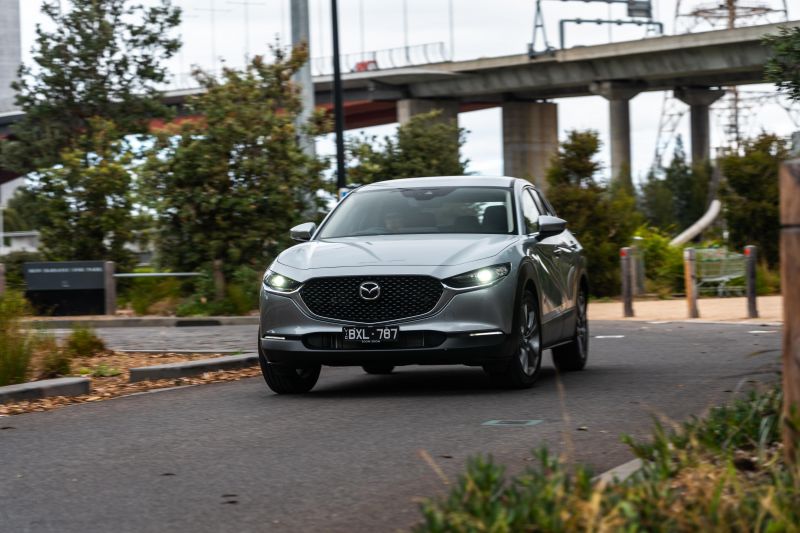
MY23 CX-30 G20e pictured
It’ll get up to speed without too much issue, hum along happily on the freeway, and iron out majority of the smaller imperfections on the road. It’s all just as you’d expect for a small SUV like the CX-30, but that doesn’t mean it couldn’t be improved.
The 2.0-litre engine in this car is fine, but it does feel a bit strained. Compared to the Mazda 3, which shares the same platform and is offered with the same two engines, in this application the G20 feels a touch weak.
In the Mazda 3, the 2.0-litre engine offers strong baseline performance and feels like an appropriate starting ground for such a car, while the 2.5-litre alternative is a faster upgrade, bringing warm-ish performance.
In contrast, in the CX-30 it seems like the G25 should be the minimum in terms of driveability and performance, because the G20 doesn’t feel particularly fast and makes quite the racket when accelerating.
On top of that, the six-speed auto can sometimes stumble from a standstill or when you’re getting on or off the throttle. None of those factors are necessarily dealbreakers, but they do dull the CX-30’s otherwise sharp performance.
The car’s on-road dynamics are handled in a satisfyingly consistent manner, which means there’s unlikely to be anything that will catch you off guard.
Ride quality isn’t perfect, but it’s not expected to be for a car at this price point. Prolonged stints on rough rural roads will reveal those flaws, and while it’s smooth enough in such situations we’d stop short of calling it plush.
Indeed, one of our biggest on-road criticisms is the ride, which we find to be somewhat harsh and bouncy.
This is not a high-end, expensive SUV, which makes it a bit easier to excuse such shortcomings than it is with any of Mazda’s large SUVs like, for example, the CX-60.
And it’s one of the only aspects of the car that may surprise you behind the wheel. If you’re going to be doing a lot of driving on rural roads, you’d better be prepared for ride quality that isn’t quite as comfortable as it perhaps should be.
Of course, the upside of the firm ride is sportier than average handling, which is clearly what Mazda has prioritised here, because the CX-30 excels in scenarios like well-surfaced windy backroads and tight city streets, which is its more likely environment and where it’s highly manoeuvrable and appropriately comfortable due to the lower speeds.
To its credit, the CX-30 also shines on long stretches of freeway. Naturally, such roads tend to be smoother and generally more gentle on the car, which means you really do notice how well Mazda has been able to keep road noise down.
At 110km/h there’s no wind noise to be heard, and there’s an impressive level of refinement. What’s better is that when you’re cruising at freeway speeds, you’d be hard pressed to notice what’s going on under the bonnet.
The high-speed shortcomings of the G20 compared to the G25 appear when you encounter a hill, as it’ll need to drop down a gear or two to make up for its torque deficit. Overtaking slower vehicles is also not as easy as it could be for the same reason.
However, in lower-speed driving through built-up areas, the CX-30 remains strong. Its consistent, nicely weighted steering feel makes it easy to navigate tight turns, while equipment like a surround-view monitor helps when squeezing into parking spaces.
Equally, visibility out of the CX-30 is surprisingly good. Though the side windows are quite narrow, they don’t impact head checks and the side mirrors provide enough visual range to be able to comfortably see what’s going on outside.
On that note though, Mazda has fitted a ‘zoomed-in’ mirror on the driver’s side only, which can be a little disorienting at first.
Because the passenger side mirror appears to be more normal, the difference between the two takes time to get used to. The zoomed-in nature also means it’s harder to see what’s immediately alongside.
The suite of safety tech helps to counter this abnormality. The blind-spot monitoring works reliably to keep you from running someone off the road, and the lane assist function steers the vehicle faithfully back if you drift to either side.
Long drives are also made easy thanks to adaptive cruise control and the associated lane-centring function.
You can comfortably rely on the system to stay in your lane and maintain a comfortable speed, though keep in mind you’ll have to take control if you want to pass someone on the freeway.
The system is on the sensitive side in terms of reacting to traffic ahead, which means it takes a moment for it to get back up to speed if the car in front is slow.
Regardless, there were no major hiccups with any of the safety systems during our week with the car, and even in inclement weather they were able to keep tabs on the road ahead and appropriately react to surrounding traffic.
Simply put, this is an exceptionally easy car to drive, but it’ll never do anything particularly extraordinary or unexpected. It’s built to serve a purpose, and it serves that purpose well.
To see how the Mazda CX-30 stacks up against its rivals, use our comparison tool
The Touring LE sits in the middle of the CX-30 range price-wise, and it’s the second-highest specification of 2.0-litre variant below the Astina.
CX-30 G20 Pure highlights:
- Mazda Connected Services
- Vehicle locator
- Geofencing
- Flashing lights feature
- Curfew notifications
- Remote locking
- Vehicle health
- Status reports
- Stolen vehicle tracking assistance
- 16-inch grey alloy wheels
- Space-saver spare wheel
- Automatic LED headlights
- Automatic high-beam
- Rain-sensing wipers
- Automatic power-folding side mirrors
- 7.0-inch digital instrument cluster
- 8.8-inch infotainment system
- Head-up display
- Wired Apple CarPlay and Android Auto
- 2x USB-C ports (replaces USB-A)
- Satellite navigation
- DAB+ digital radio
- Eight-speaker sound system
- Push-button start
- Leather-wrapped shifter
- Leather-wrapped steering wheel
- Fabric upholstery
CX-30 G20 Evolve adds:
- 18-inch silver alloy wheels
- Paddle shifters
- Dual-zone climate control
- Wireless Apple CarPlay and Android Auto
- Wireless phone charger
- Overhead sunglass storage
- Rear fold-down centre armrest
CX-30 G20 Touring adds:
- Front parking sensors
- Auto-dimming driver’s side mirror
- Reverse tilt-down driver’s side mirror
- Side mirror memory
- Keyless entry
- Illuminated front vanity mirrors
- Black leather upholstery
- 10-way power driver’s seat
- Two-position driver’s seat memory
CX-30 G20 Touring LE adds:
- Black 18-inch alloy wheels
- Black grille
- Signature spoiler
- Black mirror caps
- Terracotta ‘Maztex’ and suede upholstery
- Terracotta armrest, centre console, door card and dashboard contrast stitching
- Vision Technology Package
- Front cross-traffic alert
- Cruising & Traffic Support
- Driver monitoring system
- Surround-view monitor
- 10.25-inch infotainment system
The Mazda CX-30 received a five-star ANCAP safety rating back in 2019.
| Category | Mazda CX-30 |
|---|---|
| Adult occupant protection | 99 per cent |
| Child occupant protection | 88 per cent |
| Vulnerable road user protection | 80 per cent |
| Safety assist | 76 per cent |
Standard CX-30 safety features include:
- Autonomous emergency braking (AEB)
- Pedestrian detection
- Cyclist detection
- Rear AEB
- Blind-spot monitoring
- Rear cross-traffic alert
- Lane-keep assist
- Lane departure warning
- Driver attention alert
- Traffic sign recognition
- Rear parking sensors
- Reversing camera
- Tyre pressure monitoring
CX-30 G20 and G25 Touring add:
CX-30 Touring LE and G20 and G25 Astina add:
- Front cross-traffic alert
- Cruising & Traffic Support
- Driver monitoring system
- Surround-view monitor
The CX-30 range is covered by Mazda’s five-year, unlimited-kilometre warranty and five years of roadside assistance. Servicing is required every 12 months or 15,000km – whichever comes first.
| Running costs | Mazda CX-30 G20 |
|---|---|
| Warranty | 5 years, unlimited kilometres |
| Roadside assistance | 5 years |
| Service intervals | 12 months or 15,000km |
| Capped-price servicing | 5 years |
| Total capped-price service cost | $2237 |
| Average annual cost for the first 5 years | $447.40 |
To see how the Mazda CX-30 stacks up against its rivals, use our comparison tool
This is a solid car; no-nonsense, easy to live with, and comfortable.
The CX-30 is already a strong platform, and the Touring LE’s additions add a bit of extra spice to an otherwise straight-to-the-point recipe.
Its black and terracotta seat trim in particular is a nice touch, and while you won’t necessarily notice it on the road, you will appreciate the exceptionally comfortable seats, and the quality upholstery shouldn’t prematurely wear out over time.
The same can be said for the rest of the cabin too; the tech is all crisp and reliable, everything is ergonomically located, and Mazda’s top-notch build quality shines through with no creaks or rattles to speak of.
Practicality is strong too, with usable cupholders and plenty of storage options. The only thing lacking are back-seat amenities, but you could easily live with that if you were coming from an older car.
Indeed our only real complaints are on-road, where it’s somewhat underpowered and bouncy. The 2.5-litre engine is much more preferable over the 2.0-litre in the Touring LE, but it still gets the job done with ease if you can’t stretch to the G25 powertrain.
Given its intended purpose, the CX-30’s suspension setup could be more compliant. Damper tuning that can more comfortably handle a broader spectrum of road conditions would make for a much more complete package.
Nevertheless, the CX-30 fulfils its target role well, and as a small SUV with plenty of usable storage space in the back, it’ll easily handle whatever young families can throw at it.
The lower-spec versions may be cheaper, but there are plenty of reasons to give the Touring LE a double-take if you want a CX-30 that feels a bit more upmarket.
Interested in buying a Mazda CX-30? Get in touch with one of CarExpert’s trusted dealers here
Click the images for the full gallery
MORE: Everything Mazda CX-30

